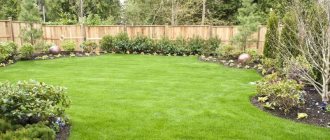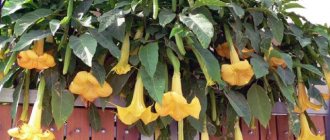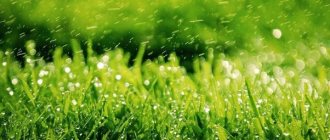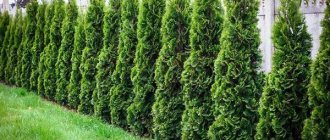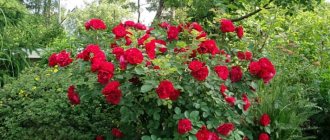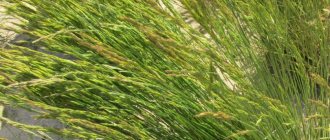So much effort was spent on mowing the lawn, aerating, fighting weeds... It would be a shame if after winter our precious lawn turns out withered and with bald spots. Consultants and experienced users of our portal tell you what measures are necessary for successful wintering of a lawn.
In this article we will cover:
- Is it necessary to do water-recharging irrigation?
- When is the last time to mow the lawn?
- How to fertilize the lawn on the eve of wintering.
- Is lawn cleaning required?
- What to do if the grass turns yellow.
- The main condition for successful overwintering of the lawn.
Should I do water-recharging irrigation?
One day in the Urals, where a member of our portal with the nickname Helen68 lives, it was a dry autumn. The average daily temperature fluctuated for several weeks from minus at night to +6 during the day. It is difficult to make the right decision in such a situation: on the one hand, you want to properly charge the lawn with moisture so that it can withstand the winter well, but on the other hand, you are afraid of causing harm.
A consultant on our portal, an agronomist with the nickname Sodmaster, believes that excess water is harmful to the lawn.
Sodmaster
In my conditions, I would consider moisture-recharging irrigation completely unnecessary. I am very, very afraid of excess water, so I can also water it in the fall, when the lawn definitely doesn’t need it.
Water-recharging watering of the lawn is not recommended.
Usually, regular watering of the lawn stops in September, and in early October they stop watering altogether. Overmoistening of the soil is unacceptable; this leads to weakening and disease of the lawn grass.
When is the last time to mow the lawn?
There is no calendar for last lawn mowing dates by region, and FORUMHOUSE consultant Sodmaster recommends “mow while you mow,” while listening carefully to your lawn and yourself. It gets cold and you don’t want to take the lawn mower, which means we cut less often and to a greater height.
Sodmaster
But I’m still inclined to do the last haircut (again, I don’t insist!) lower, so that there’s less fuss in the spring.
A member of our portal, a “lawn maniac” from Yerevan with the nickname Orhidika, advises for the last cutting to keep the grass height in the range of no lower than 4-5 cm and no higher than 7-8 cm.
Mowing as grass grows
Autumn care involves cutting the lawn grass with a lawn mower. This procedure helps reduce the consumption of nutrients for the above-ground parts of plants, thereby strengthening the root system and increasing the winter hardiness of the lawn.
Long grass will die under the influence of cold. A thick layer of organic matter will attract rodents as a place of shelter and food, and will complicate the germination of young shoots in the spring. Lawn mowing in the fall is carried out according to the following rules:
- Mowing is carried out as the grass grows. The height of the green cover before frost should not exceed 4–6 cm.
- The last time lawn grass is mowed is 14 days before the first frost. The cutting time depends on climatic conditions: in Siberia and the northern regions it is mid-September, in central Russia - the first ten days of October, in the southern regions - from late October to early November.
- Mown grass must be removed from the site. It is used to prepare compost, mulch crops, and feed livestock.
How to pre-winter fertilize your lawn
Usually in the fall we stop fertilizing with nitrogen so as not to unnecessarily stimulate the growth of green mass and not to weaken the plant, which will already have a hard time in the coming winter months. But with nitrogen the situation is somewhat different. It has been proven that autumn fertilizing with nitrogen is absolutely safe for the lawn, the only thing is that you won’t see the results of these fertilizing in the near future.
In terms of timing: you can fertilize the lawn with nitrogen at the very end of autumn, the main thing is that the temperature does not fall below +5 degrees. Under these conditions, the roots of the lawn grass can still absorb nitrogen. Having accumulated in the roots, nitrogen will “work” in early spring, and the lawn will turn green earlier than usual.
On the other hand, this fertilizer can be used with equal success in the spring.
Orchidika
When fertilizing before winter, nitrogen accumulates in the roots, and in the spring the lawn begins to grow earlier. And only you have to decide whether you need to fertilize before winter or use the same fertilizer in the spring (my preferred option).
Potassium-phosphorus fertilizers have a beneficial effect on root formation, but it is better to apply them early, at the end of Indian summer, when the soil temperature is above +10. And for watering. But you can add potassium later; it will not disappear from the lawn over the winter, and the plants will also need it in the spring.
Sodmaster
It is not so important with the timing - potassium, which acts like antifreeze in the plant, does not allow the cell sap to freeze. Even if you apply potassium fertilizer now, the potassium will be in the soil, and the plant will take it when it sees fit.
How to fertilize your lawn in the fall
Replenishing the reserves of macro- and microelements in the soil helps to strengthen and compact the root system of plants, increasing resistance to various diseases. To properly prepare your lawn for winter, you need to know how to feed it in the fall.
Formula NPK
Autumn feeding of lawn grass is carried out with mineral mixtures with a high concentration of potassium and phosphorus. Thanks to such chemical elements, it is possible to achieve early spring rapid development of a green lawn. Of particular note is the NPK formula, which consists of nitrogen (N), phosphorus (P) and potassium (K). The optimal ratio of these components is 10/30/20.
For decorative turf, it is very important to obtain enough potassium to increase the degree of frost resistance of the grass, its level of resistance to dry weather and infections. Phosphorus is essential for the formation of strong root mass.
Nitrogen should be used in moderation before cold weather, since its excess only promotes the active growth of the above-ground part of the grass. And before winter, this is not as important as a powerful root system, which will allow you to adequately endure this period.
A universal means for feeding a green carpet is a ready-made fertilizer mixture marked “Lawn Grass”. This balanced, long-acting composition fully provides plants with everything necessary for normal growth and development, and also increases the level of resistance to diseases and stressful situations. Such fertilizers for autumn feeding of the lawn are absolutely safe for children, pets and the green surface itself.
Particularly popular are the mixtures Bona Forte with the formula NPK 8/30/20 and Fertika Lawn Autumn with the formula NPK 6/13/36. In addition to the main useful components, such nutritional mixtures also contain magnesium, iron, silicon, calcium, and sulfur. It is noteworthy that when these compositions are used together with zeolites, their period of action increases to 8-9 months, which allows the gardener to apply complex mixtures only once per season.

Fertilizer selection
In specialized retail outlets there are many options for autumn lawn fertilizer. The main thing is to know the benefits of each element included in the mixture and not make mistakes when choosing.
Phosphorus-potassium compounds
This group of nutrient mixtures is used to feed both young plants and adults. The combined use of phosphorus and potassium has a beneficial effect on the root system of the grass, giving impetus to the formation of new shoots. With regular application, the lawn begins to germinate early and forms strong shoots in the fall. Phosphorus is present in complex fertilizers and superphosphate.
Potassium
The element responsible for resistance to adverse environmental factors and diseases is present in sufficient quantities in potassium salt, potassium chloride, potassium sulfate, magnesium sulfate, nitrophosphate, and potassium magnesium.
Liquid fertilizer mixtures
This form of nutritional composition is quickly absorbed by plants, and they are especially actively used to restore damaged areas of the lawn. The concentrated preparation is diluted with water according to the manufacturer’s instructions and evenly distributed over the decorative coating. Beneficial components penetrate directly into the grass tissue through the root mass.
You can also purchase weakly concentrated products to enrich lawn grass with nutrients; they are no worse than the previous ones. Such preparations are used for spraying on leaves; here the beneficial components penetrate into the roots through the above-ground part of the plants. To make the effect stronger, it is recommended to apply foliar feeding on cloudy days or late in the evening.
Liquid fertilizers have certain advantages:
- uniform distribution over the surface of the lawn;
- ease of use;
- instant action.
Nitrogen nutrition
A high content of this chemical element is noted in sodium, calcium, ammonium nitrate, ammonium, nitroammophoska, and urea. But in the fall, a green lawn does not experience a strong need for nitrogen, so it is more effective to use complex mixtures, which are ready-to-use nutritional compositions such as nitrophos, potassium phosphate, ammophos, nitroammophoska. But you need to know that you should not feed young grass with such compounds, only a year after sowing or six months later for grass in rolls.

Is lawn cleaning required?
Your lawn heading into winter should be healthy and clean. Using a special fan rake, we clear it of fallen leaves and remove the so-called felt from the grass (this procedure will reduce the risk of damping off) or use a scarifier.
Leaves should not be left on a lawn that is going into winter.
PapaTemi FORUMHOUSE Member
We have been doing maintenance on the same area for the eighth year, before winter we cut it by 5 cm and scarify it, everything was fine, but last year the client decided to save money in the fall, and the lawn was left, untreated and uncut, and unfed. In spring - snow mold on rotten rags and bald spots.
Cleaning the lawn cannot be neglected; this procedure improves the supply of oxygen to the roots of the plant and increases the chances of successful overwintering.
IgorOld FORUMHOUSE Member
On the lawn, in places where there were minor bald spots, young birch trees began to sprout. So when the earrings fall off, it would be appropriate to vacuum them once again.
In rainy autumn, aeration will not hurt, thanks to which excess moisture will drain from the lawn into the soil. This event is always held in the spring, immediately after the snow has cleared from the lawn, but it will also be appropriate in October.
Moss on the site - how to protect the grass
In addition to fertilizing, an area with grass needs timely removal of moss. This is a representative of the plant world that has no roots. Grows where there is moisture and little sunlight.
If moss has taken root on the lawn, this means that the soil is acidic. It's time to remember about lime and organic fertilizers.
Moss is an indicator of acidic soil
Additional events:
- remove the moss with a rake and burn it;
- a soda solution (a pack of 2 liters of water) is sprayed over the area;
- organize water drainage;
- remove leaves from the area so that the sun penetrates to the ground;
- do not water intensively in autumn and spring;
- use herbicides with glyphosate;
- If the grass does not grow well due to the shade, you should choose a different variety.
Moss does not tolerate iron-containing fertilizers, so it is worth using iron sulfate for watering the soil.
Autumn lawn repair
It is not advisable to send a lawn with bald spots and holes into the winter. In each hole you need to add grass (the one that makes up your lawn), cover it with fertile soil and compact it, or make “patches” of turf.
We comb out the withered grass from the bald spots, loosen the soil, sow the seeds, sprinkle with fertile soil, water and compact.
Lawn repairs will also have to be carried out in the spring; most likely, after the snow melts, you will still find bald spots. Therefore, stock up on seeds.
Ttt777ttt FORUMHOUSE Member
To reduce bald spots, at the end of winter - beginning of spring, pierce the crust with a pitchfork, sprinkle with ash - speed up the snow melting.
Aeration
In addition to the planned autumn fertilizing, experienced landscape designers recommend aerating the lawn before winter - piercing the turf with a garden fork and lightly lifting the top of the soil.
In addition to forks, aeration can be carried out using special devices worn on shoes, or with an electric aerator.
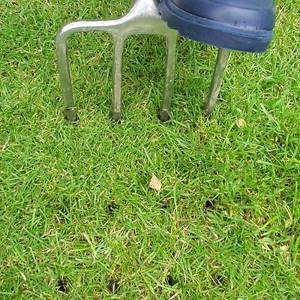
Aerating the lawn with a pitchfork
This technique improves soil drainage, allows moisture to escape into the lower layers of the soil and activates the supply of oxygen to the root system, which has a beneficial effect on the appearance of the grass stand.
By feeding your emerald lawn correctly and in a timely manner in the fall, you will be able to enjoy its lush greenery at the beginning of spring, pleasing to the eye after the snowy winter months.
What to do if the lawn turns yellow on the eve of wintering
According to Sodmaster, lawn grass is designed to survive adverse conditions and is quite difficult to “kill.” In autumn, nutrients flow from the leaves to the roots; Sensing the approach of winter, plants accumulate sugars in the rhizomes and tillering nodes - in those organs that need to overwinter and give rise to new growth. Therefore, we should not panic when the lawn turns yellow; this is a completely normal, natural process. There are studies that show that lawn grass varieties that turn yellow earlier overwinter better.
The most important condition for successfully overwintering a lawn is to prevent the formation of paths and other compactions in the snow on top of the lawn. When clearing paths, you should not store snow on the edge near the path; you must scatter it evenly over the lawn. If this is not possible, and there is only a place to store snow piles on the lawn, then at least in the spring, when they begin to thaw, it is necessary to scatter them evenly, and thereby save the lawn from damping out.
Read our article on how to properly control weeds in your lawn and another one on how to plant the perfect lawn. Watch our video about proper lawn care.
What can you feed?
At each stage of its development, the plant needs different nutrients, so summer fertilizing of the lawn will not be suitable for it in the fall. To strengthen your lawn grass and help it overcome the winter cold, you should feed it only substances that are optimally suitable for the autumn period, following the rules for preparing mixtures yourself.

Optimal composition
The main task of autumn fertilizer is to strengthen the root system of the lawn and prepare it for the upcoming cold weather. Mainly mineral substances, including potassium and phosphorus, are called upon to help with this. Both elements contribute to the full pre-winter preparation of vegetation and ensure its active revival immediately after the snow cover melts.
When it comes to the optimal ratio of nutritional components, a formula called NPK (nitrogen/phosphorus/potassium), the compatibility of the main components, which is distributed as a percentage as 10/30/20, will be relevant. Potassium in the finished mixture plays a particularly important role, since it can increase the frost resistance of the grass, increase its drought resistance and prevent the development of typical diseases. Phosphorus has a positive effect on strengthening the root system, but you should be more careful with nitrogen, as it activates the growth of the above-ground part, which is completely undesirable before cold weather.
Did you know? In the summer, a thick lawn around the house can reduce the air temperature by 3-4 degrees, especially if you have time to water the grass in the morning.
For those who doubt the correctness of preparing a nutrient mixture on their own, there are ready-made fertilizers for lawn grass. A good example of such products are the composition “BonaForte” with a ratio of main active ingredients 8/30/20 (NPK formula) and “Fertika” (NPK - 6/13/36). In addition to the substances already mentioned, such preparations contain iron, magnesium, silicon, calcium, sulfur and other minerals, the combination of which ensures a long-lasting effect, with the possibility of more infrequent feeding.


